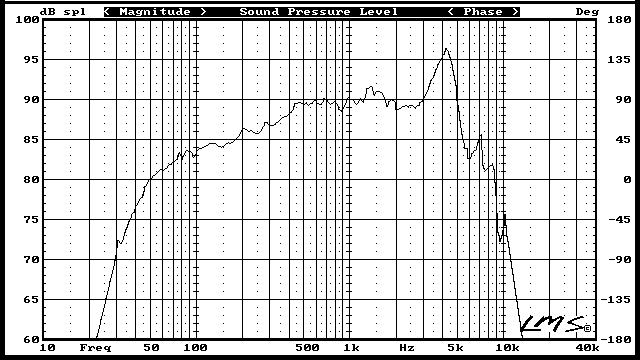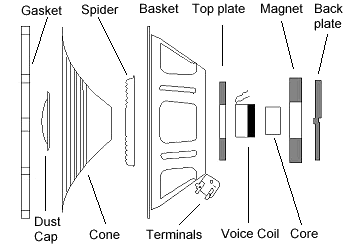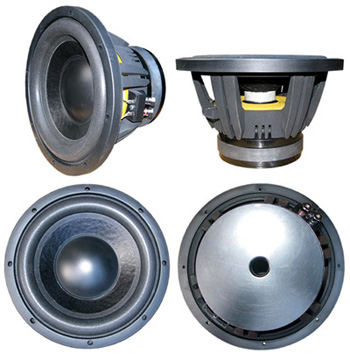I would like to address some common statements I see on car audio forums.
Larger subs play deeper.
Larger subs have more moving mass, and as such typically have a lower Fs, which will allow them to work more efficiently at lower frequencies, particularly when used in ported enclosures. Larger subs also have more cone area, and often, more excursion than the same make and model of sub in a smaller size, which allows the larger sub to move more air. The moving of more air equates to more output or volume, so while a larger sub may be able to get louder at lower volumes, pretty much any sub can produce notes lower than the range of human hearing. The simple fact is that a larger sub can produce these bottom octave frequencies are greater output, so it's louder, or more audible to the listener than a smaller sub would be at the same power input. In short, a larger sub does not play more deeply per se, but it does tend to have greater output at those lowest audible notes.

A smaller sub is faster.
This is just poppycock. The speed or detail of a sub (how fast it reacts to changes in the input signal) is a matter of numerous factors, the least of which tends to be the moving mass of the driver. How "fast" a driver is, depends more on several factors of the amplifier, the speaker, and the enclosure in which the speaker is housed.
The amplifier's slew rate, damping factor, and dynamic headroom (reserve power, dependant on the quality of the amp's power supply in large part) are factors in controlling the speaker.
The enclosure alignment chosen for the sub will have a large effect on the driver's response as well. For example, a ported enclosure tends to have more transient delay than a sealed box, whereas if you want the best driver control, an aperiodic enclosure is your best choice.
The speaker itself has several factors that determine it's "speed" as well, the largest of which is motor control, or "BL." The BL of a speaker is the biggest factor in how well the cone movement is controlled. BL is the actual cross product of the magnet field B with the conductor length L. It is not a scalar, but rather a vector. Combine this vector with the current I and you’ll get exactly the force (up or down according to the DC or AC input). But with the way amplifiers are designed, the current I of the speaker is never constant, only the voltage is. It is also not entirely important to know what the force is because is changes so rapidly. In any event, the BL squared divided by the resistance of the voice coil Re in fact gives us a generic force factor in newtons squared per watt. This number is relative for all speakers and the higher the number, the more force a motor can invoke on a cone with the same input power.
Its important to distinguish that BL and Re are related much like inductance and Re are. 32Tm over 8 ohms is identical to 16Tm over 2 ohms, namely 128 N²/W. All other things equal (moving mass and cone size in particualr), A higher BL²/Re will increase the sensitivity of the driver which is a generally a very good thing. BL Curve is a graph of the magnetic strength of the speaker's motor structure across the frequency spectrum of the speaker's operating range.
In short, a smaller sub is not automatically faster than a larger sub.

Which is better; several small subs, or one large sub?
Well, this also depends on a few things. We'll assume right off that you have the room for either configuration in the vehicle. What you want to compare is driver sensitivity, which tells you how much sound you get from the speaker (output) per watt of input. Another thing to consider is cone area. Compare cone atea by finding the surface area of each speaker (π*R²) and add the sums together if using multiple drivers. Compare this with the surface area of the single sub, then compare the combined excursions (Xmax) as well. This will tell you the total surface area of the sub(s) along with their excursion(s) and sensitivity, which are the main factors, if using the same type of box for both setups. Typically I prefer to go with the larger sub(s) whenever possible.

Larger subs don't play as high as smaller subs.
This is also untrue. Here is a chart demonstrating the theoretical maximum frequency for speakers, based on cone diameter:
Speaker Diameter (inches) |
Theoretical Maximum Frequency Before Beaming (Hz) |
.75 |
18,240 |
1 |
13,680 |
2 |
6,840 |
3 |
5,472 |
5 |
3,316 |
6.5 |
2,672 |
8 |
2,105 |
10 |
1,658 |
12 |
1,335 |
15 |
1,052 |
18 |
903 |
With the above chart in mind, remember that typically a subwoofer shouldn't really be run with a LPF set any higher than about 60Hz, with a slope no shallower than 18dB/octave in most situations, so even for an 18" subwoofer, you should never run into an issue with the speaker maxing out at it's LPF frequency.

